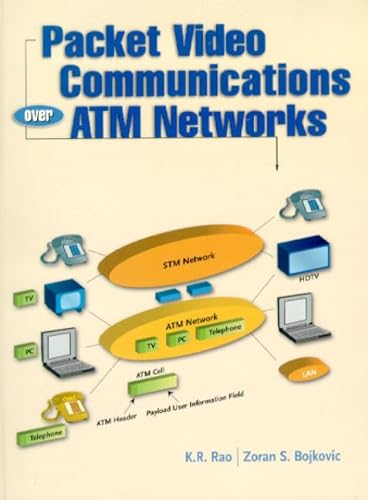Packet Video Communications over Atm Networks - Hardcover

"synopsis" may belong to another edition of this title.
Five broad aspects characterize a modern communications network:
Transmission. A means of transporting bits across a medium.
Switching, routing. Given an "increment of information" (a frame, a cell, a circuit), determine the destination of that increment.
Signaling. Provide a method by which users can describe to the network what they want to do.
Services. Provide "something of value" that the user wants.
Management. Provide for the handling of faults, connections, and traffic flow.
These five terms have existed and have been used for a long time in the communications industry. They have, however, over the years become confused, redefined, misapplied, and indistinct. In the "old" days when there was only circuit switching and the function was performed by mechanical switches, transmission was analog over twisted pair subscriber loops, signaling was by dial tone/pulse dialing, and services included end-to-end telephony/long distance/operator assistance. The terms were fairly obvious.
The ability of Asynchronous Transfer Mode (ATM) networks to combine voice, video, and data communications capabilities in a single network are expected to make ATM the networking method of choice for video delivery in the future. The ATM Forum is currently developing standards to address the issues associated with video delivery. The marriage of communications and computers has opened a new era in interactive audio-visual applications. The Audiovisual Multimedia Services Technical Committee is currently addressing the issues relating to numerous video applications, including broadcast video, videoconferencing, desktop multimedia, video on demand, interactive video, near video on demand, distance learning, and interactive games. Packet video communications over ATM networks is a rapidly evolving field with growing applications in science and industry 1, 257.
Packet Video Communications over ATM Networks provides a comprehensive coverage of various surveys of the current issues relating to video delivery over ATM networks. This book addresses the fundamentals of the major topics of video communications over ATM networks: asynchronous transfer mode technique, scalability, MPEG digital video standards, quality of service, and multimedia communications. We have focused our attention on mature topics with the hope that the level of discussion provided will enable an engineer or a scientist to design a packet video communication system over ATM networks or conduct research on advanced and newly emerging topics. The objective of this book is not only to familiarize the reader with packet video communications over ATM networks, but also to provide the underlying theory, concepts, and principles related to these problems, including the power and the practical utility of the topics. In most cases, the applications are described conceptually, rather than in detail.
A major challenge during the preparation of this book was the rapid pace of development, both in software and hardware related to packet video communications over ATM networks. Many specific applications have been realized in the past few years. We have tried to keep pace by including many of these latest developments. In this way, it is hoped that the book is timely and will appeal to a wide audience in the engineering, scientific, and technical communities.
In addition, we have included more than 180 figures and over 518 references. Although this book is primarily for graduate students, it can be also very useful for academia, researchers, scientists, and engineers dealing with packet video communications over ATM networks.
Packet Video Communications over ATM Networks
Video on ATM networks: fundamental theory and practical network design
Packet video over ATM is increasingly the technology of choice for a wide range of "converged" network multimedia applications, including videoconferencing, distance learning, video-on-demand, and Internet-based multiplayer gaming. Packet Video Communications over ATM Networks brings together the practical and theoretical information professionals need to design ATM-based video networks for maximum performance, reliability, and flexibility.
The authors first introduce networked packet video, its advantages, applications, and challenges. They review each aspect of an ATM network relevant to packet video, including ATM layers, packetization techniques, buffering, and video coding. Next, they address each leading approach to increasing the scalability of ATM-based video networks, including data partitioning; SNR scalability; and spatial, temporal, and hybrid scalability. Coverage also includes:
* Fundamentals of MPEG-1, MPEG-2, MPEG-4, and MPEG-7 compression
* Rate control, multiplexing, video delay, and jitter
* State-of-the-art error and loss concealment strategies
* Asynchronous transfer of video across the public Internet
* Controlling Quality of Service: service classes, QoS parameters, requirements, coding techniques, and traffic management
* Distributed multimedia video systems, including interactive television and related services
Packet Video Communications over ATM Networks reflects the latest work in the field, providing both underlying theory and principles and today's best design techniques. For video and telecommunications engineers designing or deploying networked video, it will be an invaluable resource.
"About this title" may belong to another edition of this title.
- PublisherPrentice Hall
- Publication date2000
- ISBN 10 0130115185
- ISBN 13 9780130115188
- BindingHardcover
- Edition number1
- Number of pages420
Buy New
Learn more about this copy
Shipping:
US$ 31.27
From United Kingdom to U.S.A.
Top Search Results from the AbeBooks Marketplace
Packet Video Communications over Atm Networks
Book Description Hardcover. Condition: New. New. book. Seller Inventory # D8S0-3-M-0130115185-4

